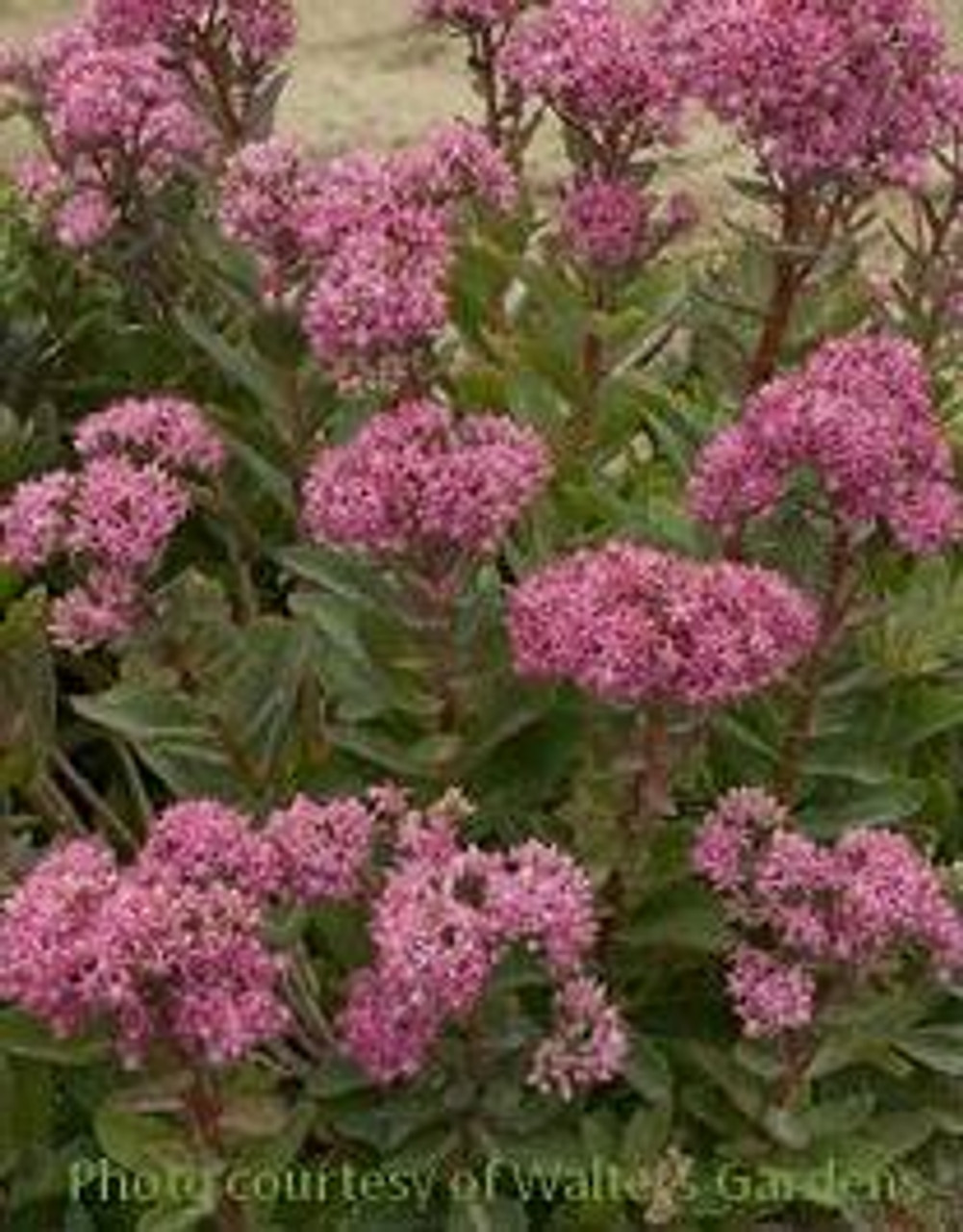Product Description
Sedum 'Carl' (25) Bare Root Plants
Common name: Stonecrop-Autumn. a/k/a Hylotelephium
This English variety is distinguished from ‘Autumn Joy’ by its compact habit and large clusters of brilliant magenta pink flowers held on reddish stems from late summer into fall. Compared to the more muted pink colors of some older sedums, this one really packs a punch when it’s in bloom.
Rounded, slightly serrated, grey green leaves form a densely mounded, upright clump.
Tall, upright sedums form substantial clumps of foliage which can be substituted for shrubs in the landscape. Their stout, sturdy stems support the massive flower heads which develop in summer and burst into bloom in fall. If left standing, they provide winter interest and food for birds.
Sedum is one of the most popular perennials grown in American gardens because it is very easy to grow and hardy in most areas of the country. Because of its thick, succulent leaves which can store water, sedum is drought tolerant. It should be sited in average to poor soil that is well-drained. Plants grown in rich soil tend to be lanky and open. Most varieties should be grown in full sun to light shade. The lower growing types, however, will survive in partial shade.
This plant is not usually bothered by pests or diseases. The seed heads of the taller varieties provide excellent winter interest and food for birds. Remove them in spring when the new growth begins to show.
Royal Horticultural Society's Award of Garden Merit -- 2012
Height: 18 Inches
Spread: 18-24 Inches
Hardiness Zones: 3,4,5,6,7,8,9
Flower Color: Pink shades
Foliage Color: Green shades
Full Sun (> 6 hrs. Direct Sun)
Low to Average Water Needs
Poor to Average Soil Quality
Bloomtime: Late Summer - Mid Fall
Attracts Butterflies
Bee Friendly
Rabbit Resistant
Seasonal Interest: Dried Seed Heads, Fall Color
Growth Rate: Medium
Border Plant, Container, Cut Flower, Cut Foliage, Dried Flower, Drought Tolerant, Easy To Grow, Edging, Attractive Foliage, Mass Planting, Salt Tolerant
Sedum 'Carl' is a lovely and reliable perennial that adds a burst of vibrant color to the garden, particularly in late summer and fall. Here is a breakdown of its key features:
Appearance:
- Foliage: Features thick, fleshy, gray-green leaves that are rounded and slightly serrated. They form a dense, mounded clump.
- Flowers: Produces large clusters of brilliant magenta-pink flowers that appear in late summer and continue into fall. The flowers are held on sturdy, reddish stems, adding to the visual appeal.
- Form: Grows in a compact, upright mound, typically reaching about 16-18 inches in height and 12-15 inches in spread.
Growing Conditions:
- Sunlight: Prefers full sun (at least 6 hours of direct sunlight daily).
- Soil: Thrives in well-drained soil. It can tolerate a variety of soil types, including sandy, loamy, or even poor soil.
- Water: Once established, it is drought-tolerant and requires minimal watering. Avoid overwatering, as it can lead to root rot.
- Hardiness Zones: Suitable for USDA hardiness zones 3-9, making it adaptable to a wide range of climates.
Benefits:
- Vibrant Color: Provides a stunning display of magenta-pink flowers in late summer and fall, adding a pop of color to the garden when many other plants are fading.
- Compact Habit: Its compact size makes it suitable for smaller gardens or container plantings.
- Low Maintenance: Easy to care for and requires minimal attention.
- Attracts Pollinators: The flowers are a magnet for butterflies, bees, and other beneficial insects.
- Deer Resistant: Generally resistant to deer browsing.
- Versatile: Can be used in various garden settings, including borders, rock gardens, and containers.
- Winter Interest: The dried flower heads can remain standing through the winter, providing visual interest.
Care Tips:
- Planting: Plant in spring or fall. Space plants about 12-15 inches apart.
- Pruning: Cut back the stems to the ground in late winter or early spring before new growth begins.
- Fertilizing: Generally, does not require fertilization, but a light application of a balanced fertilizer in spring can be beneficial.
- Division: Divide clumps every few years to prevent overcrowding and rejuvenate the plant.
Sedum 'Carl' is a fantastic choice for gardeners looking for a low-maintenance, colorful, and pollinator-friendly plant. Its compact size and vibrant blooms make it a welcome addition to any garden.
Other Details
The most important part of the plant is its root system. Healthy roots are the foundation of a healthy, vibrant plant. The type of plug container used is based on the specific needs of the plants. Perennials offered as bare root traditionally perform better when planted as bare root.Planted in a specialized mix, potted plants have well established root systems. Top growth stage will vary depending on the current life cycle and time of year when shipped. In Winter and early Spring dormant plants may be shipped. Dormant plants may be planted right away, even before the last frost date.
Most bare root varieties are field grown for at least one season, though Hemerocallis and Hosta are grown for two seasons. The bulk of the soil is removed during the harvesting process and the tops of most varieties are trimmed back to the crown. They are graded, packed in shredded aspen or sphagnum moss and stored in freezers until ready to be shipped.
See our Container Sizes and Bare Root Perennials pages for more information.
Plant information and care is provided in the Overview section, Plant Genus Page and general information is provided in the Planting Care & Guides. Additional questions can be asked on each Plant page.
Plant Spacing: Using the maximum mature spread or width of a plant to guide spacing, ensures space to grow to full size. To fill an area sooner, plant them closer together. Just remember, future thinning or transplanting may be needed.
Water: Keep a close eye on newly planted perennials, especially throughout the first growing year. Most early plant loss is due to too much or too little water!

















